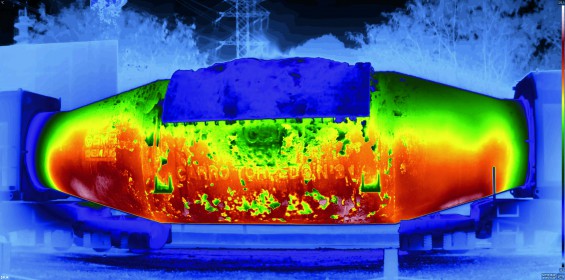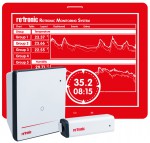Continuous thermal imaging prevents breakouts
Published: 21 June, 2019
Steel breakouts are catastrophic process failures that are both extremely dangerous and costly. Monitoring the health of ladles and torpedoes using thermal imaging can greatly minimise the risk but a handheld infrared camera can only provide a periodic check on the health of these critical transport structures. PWE reports.
ANT Automation has overcome this limitation by developing a system that provides continuous thermal monitoring and at its heart is FLIR thermal imaging.
“Many steel mills have a handheld camera and they maybe go in once a week or every couple of days to take some pictures of the ladle”, explains ANT Automation’s Javier Barreiro. “While these surveys can provide valuable information, the probability of catching a hot spot is very low during a routine inspection. You could be in normal operation and have a refractory brick break creating a hot spot in less than a minute.”
Continuous monitoring is clearly the answer but it isn’t practical, cost-effective or safe using manual imaging. For many steel mills, ANT Automation’s CIRA (continuous, infrared analysis) platform is providing a good solution. It is an integrated machine vision system that is totally automatic, requiring no human intervention.
Barreiro continues: “We capture a hot spot in the early stages by analysing and tracking the history of the ladle. Every ladle has a unique ID and it is imaged from multiple angles during each use; historical data provides insight into any problem areas. The system differentiates between developing hot spots and normal plant activity such common splashes, spill-over or overflow.”
CIRA operates on the plant’s existing network and relies on multiple FLIR fixed mounted thermal imaging cameras to monitor the entire surface of the ladle or torpedo. The model ANT Automation chooses for this task is the FLIR A315 with 320 x 240 pixels resolution that provide 76,800 unique thermal data points.
The high-frequency streaming capability of this camera can achieve full-frame 16-bit images up to 60Hz which can be fully controlled via PC. With an appropriate housing, the FLIR A315 stands up to hostile steel mill environments.
“We always recommend FLIR cameras”, says Barreiro. “They are robust, work in many different conditions and the way they stream data is very convenient.”
Users of the CIRA system can access live video data, view historical images and customise alarms from a PC or mobile device. If a hotspot is detected, the system automatically sends an email including the ladle number, temperature and associated thermal images. This early warning gives users time to grade the seriousness of the problem and take the most appropriate action. Javier Barreiro adds that this insight creates value beyond breakout prevention. He advises: “Customers can optimise their refractories, have better understanding of the ladle profile and use the information to improve the process…
“It has become common for CIRA users to install the system with several cameras, only to expand it in the following months. They maybe start with two, then install five and maybe ten as they appreciate the value of monitoring.”
According to ANT Automation, steel mills choose CIRA and other continuous monitoring systems for different reasons, some as simple as cheaper insurance premiums. “Whether it’s to refine maintenance processes or to better protect nearby equipment, most plants adopting the platforms had experienced breakouts in the past. To my mind, that’s much too late, we need to prevent this from happening from the start.”






 ROTRONIC has developed its new Rotronic Monitoring System (RMS). The advanced monitoring system checks, documents and visualises all required measurements in one system. The data can be retrieved from anywhere, at any time by PC, Mac, tablet or smartphone. The system offers high performance, flexibility and versatility and is easy to set up and operate.
ROTRONIC has developed its new Rotronic Monitoring System (RMS). The advanced monitoring system checks, documents and visualises all required measurements in one system. The data can be retrieved from anywhere, at any time by PC, Mac, tablet or smartphone. The system offers high performance, flexibility and versatility and is easy to set up and operate.
